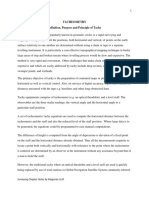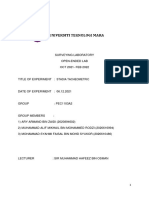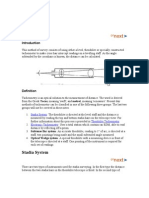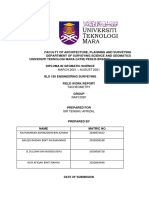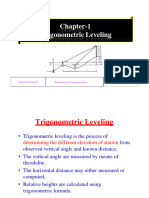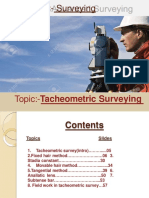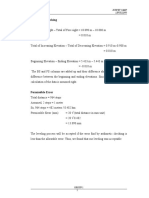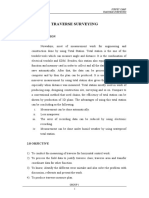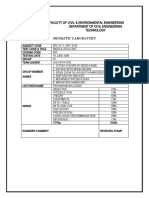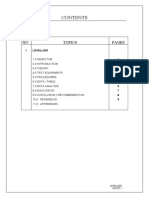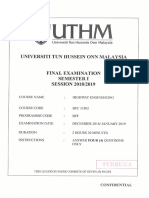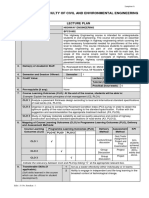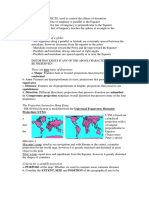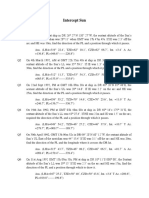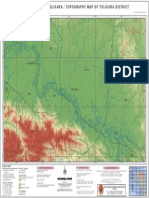SURVEY CAMP
TACHYMETRY SURVEYING
1
TACHYMETRY
1.0 INTRODUCTION
Tacheometry or tachymetry is the method of surveying by which distance and
heighting and information can be determined from theodolite observation on either a
leveling staff (stadia system) or a horizontally mounted bar (subtense system).
The most common method of measuring horizontal distances is chaining and that
for measuring vertical distances is differential leveling. Both of these methods give
results to the required accuracy. Chaining, however, on rough grounds does not
furnish very accurate results. When the ground is rough and more observations at a
faster rate with ordinary precision are acceptable, then tacheometry is the choice.
For stadia tacheometry vertical angles need to be measured when the theodolite’s
line of sight is inclined. Stadia marks on the instruments diaphragm relate the staff
intercept to the slope distance.
Methods of tacheometry can be classified into two groups are:
(a) Optical Tacheometry
i) Stadia System :
The theodolite is directed at the level staff and the distance is measured by reading the
top and bottom stadia hairs on the telescope view.
ii) Subtense Bar system:
An accurate theodolite, reading to 1" of arc, is directed at a staff, two pointings being
made and the small subtended angle measured.
iii) Optical Wedge system:
GROUP 1
� SURVEY CAMP
TACHYMETRY SURVEYING
2
A special theodolite with a measuring device in front of the telescope s directed at a
staff. One pointing of the instrument is required for each set of readings.
(b)EDM Tacheometry
i) Theodolite Tacheometry:
An instrument for measuring both horizontal and vertical angles, as used in
triangulation networks
ii) Electronic Tacheometry:
Uses a total station which contains an EDM, able to read distance by reflecting off a
prism.
2.0 OBJECTIVE
2.1 To process fieldwork data and transfers the surveying data to computer.
2.2 To identified the difference and mistake that have been done and solve it
using consultation, references and work presentation.
2.3 To produce a complete Tacheometry survey plan by using computer and
manual.
GROUP 1
� SURVEY CAMP
TACHYMETRY SURVEYING
3
3.0 THEORY
In this survey, the surveying method is quite same like tacheometry stadia. The
different by using this method, the staff is changed by using the mini prism which is
set with the pole.
h
θ
Prism
(STN B)
Total station
(STN A)
GROUP 1
� SURVEY CAMP
TACHYMETRY SURVEYING
4
Tacheometry survey by using the total station.
Height difference (AB) = H.I + V – h
H.I = Height instrument
V= Vertical component
(+ve for upwards angle / -ve for downwards angle)
h = Height pole
Level determining
If we know the level of STN A, we also can know another level station by
using this formula:
Level STN B = Level STN A + H.I + V – h
Before we start our tacheometry survey, all of this matter should be highlight such as ;
a) Survey the location
It is very important thing before we start the surveying project and it is must be
done in the entire location for putting the suitable station.
In the tacheometry survey, there is certain station which has horizontal and
vertical control that we need to get the information for more accurate the value of
tachometry.
The spot height and the coordinate value can we get from tacheometry survey and
point of coordinate by using the tachometry theory.
b) Traverse horizontal control
GROUP 1
� SURVEY CAMP
TACHYMETRY SURVEYING
5
Before we do the tacheometry survey, all the details information from the
horizontal stations framework must be done. All the stations can be adjusted by
using the theodolite traverse method. Theodolite traverse must be obey the rule of
traverse at least for the second class which is misclosure is 2’30”, the distance
taken is close to 0.001m and its linear is 1:4000 above. This traverse must be in
surveying area for determined its location from the traverse control.
c) Vertical control
Leveling second class method is used in vertical control. The leveling from the
bench mark must be move to each traverse station for move to each item taken.
d) Item taken
During in tacheometry work, all of this information must be taken in the book ;
1. The height of theodolite instrument.
2. Azimuth or horizontal angle should be to item direction.
3. Vertical angle either upwards or downwards.
4. Values of stadia.
GROUP 1
� SURVEY CAMP
TACHYMETRY SURVEYING
6
4.0 EQUIPMENTS
i) 1 Set Total Station
ii) 2 tripod
iii) 2 mini prism
iv) 2 pole
v) 1 set Leveling Equipment Automatic
vi) 2 staff
vii) 2 Leveling Bubble Set
viii) Measurement tape
GROUP 1
� SURVEY CAMP
TACHYMETRY SURVEYING
7
5.0 PROCEDURES
i) Tachymetry is a forward work traverse and leveling, where the data
was observed from traverse control points which are high value.
ii) Before started the work, we was make sure that all traverse station has
its own reduce level (leveling data is needed).
iii) All the permanent data was observed such as building, road, gate, drain
and others.
iv) The equipment was set up at any traverse station, as example at station
2 and prism/pole at station 1 or station.
v) Bearing was set up to the station 1 or station 2. The bearing data
observed was used from traverse work.
vi) The distance from station 2 to station 1was observed and recorded. A
mini pole and prism was made as a target for reference station. The
bubble was made sure at the middle to get the straight and stable pole.
GROUP 1
� SURVEY CAMP
TACHYMETRY SURVEYING
8
vii) The height of pole for every point was taken. The height of pole can be
change if any situation and it must be recoded.
viii) Referring bearing reading (HR), horizontal distance (HD) and vertical
distance (VD) that observed for every data taken was recorded.
ix) All the data that can be seen from station 2 was observed.
x) Move the equipment to the other station if all data surrounding station
was observed. The total station and pole was measured before we
moved it.
xi) Observation was taken from the next station without observed the same
data from station 2.
5.1 RECORDING
i) Recording was directly done at site area using observed form.
ii) Height of total station (IH) was recorded for every station.
iii) Height of pole was recorded for every object or point observed.
iv) Bearing reading was recorded with simplifying to degree and minute at left
crossing.
v) The distance was recorded is horizontal distance (HD).
vi) Every object observed was jotted down. Ruff sketching for condition of
object and area of site for every station was done to easier the plotting
work.
GROUP 1
� SURVEY CAMP
TACHYMETRY SURVEYING
9
6.0 DATA PROCEEDING
a) According to observed data, all data was transferred to computer to
produce level plan and object for survey area.
b) All value of reduce level, contour line, observed object and TBM location
was noticed clearly and using suitable scale.
GROUP 1
� SURVEY CAMP
TACHYMETRY SURVEYING
10
GROUP 1
� SURVEY CAMP
TACHYMETRY SURVEYING
11
GROUP 1
� SURVEY CAMP
TACHYMETRY SURVEYING
12
GROUP 1
� SURVEY CAMP
TACHYMETRY SURVEYING
13
GROUP 1
� SURVEY CAMP
TACHYMETRY SURVEYING
14
7.0 DATA ANALYSIS
Formula:
Determination of height difference:
Height difference (AB) = H.I ± V – h
Determination of reduce level:
Reduce level of station B = reduce level of station A + height difference
Example (station 21 – station 22):
Leveling station = 3.904 m
Height of equipment = 1.580 m
Bearing = 83o 37’ 00’’
Vertical distance = 0.132 m
Horizontal distance = 16.948 m
Height of pole = 1.50 m
Therefore,
Height difference (AB) = H.I ± V – h
= 1.580 + 0.132 – 1.5
= 0.212 m
Reduce level of station B = reduce level of station A + height difference
= 3.904 + 0.212
= 4.116 m
GROUP 1
� SURVEY CAMP
TACHYMETRY SURVEYING
15
8.0 DISCUSSION
The survey work on tachymetry that we have done was the extension from the
traverse survey and leveling survey that we have done before. From this survey work,
the distance and vertical distance between two surfaces can be obtained in order to
produce the tachymetry plan/topography plan. The data is taken based on the station
that we have set during the traverse fieldwork which is at the Dorm 1 ( Girl’s Dorm ).
There are obstacles that we were facing during the survey work such as :
Sandy soil surface which give us a hard time to established the leveling
equipment.
The pole is not under the stable condition and the bubble is out of circular
level.
The height of pole changed unexpectedly during field work because the
pole is loose.
In order to get more accurate results, the few precaution steps should be
considered. The following are few precaution steps:
1) Ascertain that surveyors have not dropped a traverse line.
2) Make sure that surveyors copied all bearings and distances correctly.
3) Repeat the observation several times and use the average as the result.
4) The location of station should be chosen on firm ground in positions where
the maximum amount of detail survey and/or setting out can be carried out,
bearing in mind that:
a) It must be possible to set the instrument up over the station;
b) It must be possible to read the required angles;
c) Short traverse legs should be in position unlikely to be disturbed by
future construction work.
GROUP 1
� SURVEY CAMP
TACHYMETRY SURVEYING
16
9.0 CONCLUSION AND RECOMMENDATION
9.1 CONCLUSION
Tachymetry is used to produce a plan of certain area for giving the
information to civil engineering purpose. Tachymetry can measure the object or point
at surface of earth. Besides, it can also produce topography plan which including
contour line and information for planning purpose of construction project such as
highway and building.
Overall, the objective of this survey work has been achieved. We have
produced a complete Tachymetry survey plan by using the SDR Mapping and Design
software and this plan it is same with the real plan on the location.
As a conclusion, the tachymetry was done properly and smoothly with
cooperation of every group members in our group. The relationship between traverse
and leveling was applied in the tachymetry. The information of traverse work and
leveling work which necessary for tachymetry work are bearing value, reduce level
and others information related. The information that we gained from tachymetry work
is used to plotting the object or point and contour at some area that we observed. The
plotting information are important in civil engineering career and that information
will be used in the construction work such as building construction, highway
construction and others engineering work related. The tachymetry information will be
used in the earthwork process in construction to estimate the cost and method use to
make sure the project cost are economical and safe.
GROUP 1
� SURVEY CAMP
TACHYMETRY SURVEYING
17
9.2 RECOMMENDATION
As a recommendation to get accurate measurements, we must :
i) The total station has to be centered on target.
ii) The total station must be use carefully and correctly.
iii) The lateral refraction, wind and atmospheric effects have to be avoided.
iv) The mistakes in reading and booking have to be avoided too.
v) The total station has to be in stable condition and the bubble is inside the
circular level.
vi) Before move the total station to another location, the data such as height
of total station, reduce level, bearing, vertical distance and horizontal
distance have to be ensure taken all without left any reading.
vii) The pole has to be in stable condition when observed by total station.
GROUP 1
� SURVEY CAMP
TACHYMETRY SURVEYING
18
10.0 REFRERENCE
1. A. Bannister & R. Baker, ‘SOLVING PROBLEM IN : SURVEYING’
(1994), Prentice Hall.
2. Masiri Kaamin, Abd. Shukor Sarif, ‘KEJURUTERAAN GEOMATIK 1’
(2006), Panel Kejuruteraan Geomatik, Jabatan Kejuruteraan Pengangkutan,
Geoteknik dan Geomatik.
3. Kelana Juwit, ‘UKUR KEJURUTERAAN 1 dan II’, Modul Politeknik
Malaysia.
4. Kertas Arahan Amali, Amalan Kejuruteraan Awam BFC 2111/BFC 3133,
Fakulti
Kejuruteraan Awam.
GROUP 1















